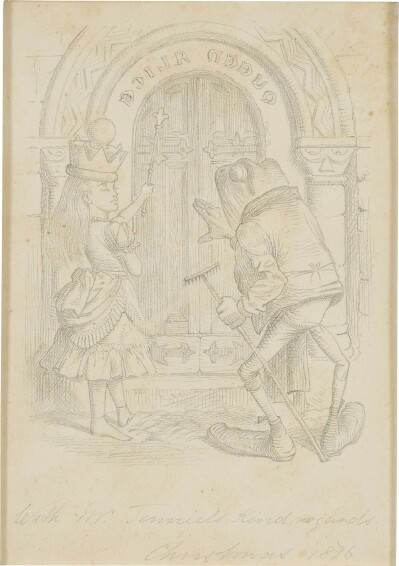- 58
Tenniel, John
Description
- Inscribed J Tenniels kind regards Christmas 1876 lower center
- Pencil on paper
- 4 5/8 x 3 1/8 inches
Provenance
Literature
Condition
In response to your inquiry, we are pleased to provide you with a general report of the condition of the property described above. Since we are not professional conservators or restorers, we urge you to consult with a restorer or conservator of your choice who will be better able to provide a detailed, professional report. Prospective buyers should inspect each lot to satisfy themselves as to condition and must understand that any statement made by Sotheby's is merely a subjective qualified opinion.
NOTWITHSTANDING THIS REPORT OR ANY DISCUSSIONS CONCERNING CONDITION OF A LOT, ALL LOTS ARE OFFERED AND SOLD "AS IS" IN ACCORDANCE WITH THE CONDITIONS OF SALE PRINTED IN THE CATALOGUE.
Catalogue Note
This charming drawing depicts Alice wearing her crown and the Frog standing in front of an arched doorway. The words "QUEEN ALICE" appear lettered backwards above the door. A presentation inscription in pencil is below the drawing: "With Mr. Tenniel's kind regards, Christmas 1876."
The collaboration of Lewis Carroll and John Tenniel began after Carroll had completed his own illustrated version of Alice's Adventures in Wonderland in 1863. By July he decided to publish the manuscript, but given his shortcomings as a draftsman—particularly in depicting animals and creatures—he cast about for a professional and skilled illustrator. He admired Tenniel's Aesop and whimsical Punch animal fillers and succeeded in obtaining an introduction to the artist at his studio in January 1864. By 5 April Tenniel had agreed to illustrate Alice.
From the very beginning, their collaboration was tempestuous. Rodney Engen attributes the strained tenor of their working relationship to their similar personalities, being "fastidious, if not obsessed, by their work" (Engen, p. 35). Despite their antagonism, the definitive Alice was published by Macmillian in 1886. It was so well received by the reading public that within months of its publication, Carroll decided upon a sequel with the tentative title of Looking-glass House. Carroll again turned to Tenniel to illustrate the book, but Tenniel rejected the proposal. Carroll was forced to appeal to other artists but found no one amenable to the project let alone auitable. Tenniel finally relented and it would take three years before the illustrations were completed.
For all the illustrations, Tenniel would prepare preliminary sketches in pencil, then in pen and ink with Chinese white to imitate engraved lines. With tracing paper, he transferred the pencil outline of each drawing onto the woodblock and worked the shading on the block with a hard 6H pencil. the Dalziel brothers would engrave the blocks and return proofs of his drawings for correction.
Producing the drawings and wood-engravings was so drawn out and tedious that Tenniel became wholly disenchanted with the process and forswore illustrating books again. "'I am completely weary of drawing on wood, perfectly sick of wood engraving,' he wrote to the Once a Week publisher" (Engen, p. 38). Years later, he reflected, "It is a curious fact that with Through the Looking-glass the faculty of making drawings for book illustrations parted from me, and notwithstanding all sorts of temptiing inducements, I have done nothing in that direction since" (quoted in Engen, p. 38).
A key illustration for the first edition of Through the Looking Glass, with a presentation inscription.

